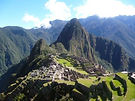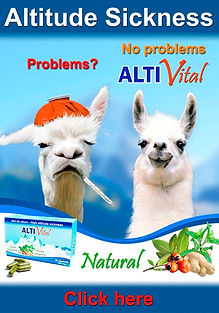PERU INFO
Home > About Peru > Society > Daily life
About Peru
Daily life in Peru
Population
33'035,000 inhabitants (estimate on 2021)
Source: Instituto Nacional de Estadísticas e Informáticas - INEI
Urban: 74% / Rural: 26%
0/14 years: 30.5%
15/65 years: 63.1%
+ 65 years: 6.4%
Life expectancy
Average: 76 years
Men: 74 years
Women: 77 years
Source: Estadísticas Sanitarias Mundiales 2009 – OMS
Ethnic groups
Ameridians: 48%
Mestizos: 37%
Whites: 12%
Black, Asiatic: 3%
Languages
Spanish: 80.3%
Quechua: 16.2%
Others: 3.5% - Aymara (Puno) and 43 dialects in Amazon rainforest
Religion
Catholic: 89.3%
Evangelical: 6.7%
Other: 2.5%
Non-religious: 1.5%
The Andean syncretism
Many Indians have preserved their ancestral beliefs as well as Catholic, they continue to venerate the natural elements such as Inti (Sun), Apus (mountains) and especially the Pachamama (Mother Earth) the land that feeds for which they regularly practice festivals and ceremonies, sometimes unconsciously as the instinctive ritual of throwing down on the ground the first drops of a drink.
Labour
Legislation
The minimum vital salary in 2021 is S/.930 (US$ 230 - 200 €) per month. By night hours (from 10:00 pm to 6:00 am) a charge of 35% is applied.
Maximum working hours: 8 hours per day and 48 hours per week.
The employee gets 12 months salary and bonus in July and December according to the working entity. The retirement age is 65 years old.
Many employers do not respect these basic rules and often one can found wages below the minimum salary or days of 10/12 hours, and even a lot are undeclared and deprives workers of social protection and retirement.
unemployment
The unemployment rate in Peru is officially 6% in 2014. By knowing that no exist an entity controlling unemployment, neither employment agencies and even less unemployment state benefits in the country, how can one determine the unemployment rate?
It is also impossible for a fit person stay several days not working because nobody would supply the minimum vital and appear informal jobs to survive as street vendors, shoe cleaners, parking attendants, private urban transport controllers, etc.
Many families must find a solution to survive on their own. There are many "self-employed", usually street vendors, sometimes children over three years old, trying to make enough money for daily food.
Concerning extra jobs, there is no financial support from the state in Peru. For this reason, many workers must find an additional resource to complete his salary such as police using their Sabbaths as security guard in banks or companies.
Several professionals and retirees, especially in Lima, must "taxear" (informal taxi driver) using their own cars or rent one.
Retirement
As for Essalud (state health insurance), only persons declared can benefit from a pension after 65 years of age. This amount becomes obviously calculated according to the years of contributions and wages. The minimum in 2021 is 250 soles (US$ 60 - 55 €), below the poverty level.
Insurance
For a few years, private insurers appearing. In Peru very rarely houses or apartments are assured for lake of habit, but mostly for lack of money to pay high quotes, hoping that the house did not catch fire, it is not damaged by an earthquake, or not burgled, in this case one can lose everything. That is why we can see in cities, houses and buildings surrounded by an electric fence or irons, security guards at each corner to protect from theft.
For auto insurance, only new cars have collision coverage. In Peru exist a compulsoty insurance since 2002 (US$12 - 10 € / year) that covers people but not the car. This medical insurance in case of accidents is basic and limited. It is estimated that 30% of vehicles are driven without insurance.
Health
As in all developing countries, there are significant health inequalities in Peru.
For a minority of Peruvians exists ESSALUD (state health insurance), but only for those quoted by a declared employment (most are undeclared or independent) but in last years Peru has created an independent insurance at the same entity.
One must go to a assigned hospital and to get an appointment must often wait several weeks.
Only in exceptional cases, a doctor may coming home.
The surgical interventions are not all covered by insurance depending on the type of insurance and coverage.
For all others who do not have health insurance, they can approach a basic municipal or local health center especially in remote places in the Andes and Amazon. Often NGOs or Charitable Organisations such as Rotary organize free medical care or preventive social campaigns.
but access to medicine increased in Peru. In large cities for example, now we can find "Hospitals of Solidarity", where you can receive care at reasonable prices and good service quality.
The privileged classes heal in private clinics and employees of big companies benefit from these clinics with a more or less important discount rates.
The quality of medicine in ESSALUD is variable. However many state hospitals have the equipment of last generation and excellent doctors.
Most of the residents of poor neighborhoods and those living in the countryside, cured with medicinal plants. Fortunately, many are efficient. Also consult shamans or healers more or less serious.
HIV seropositivity rate: 0.5%
Natural medicine
The Peruvian government declared National Cultural Heritage the knowledge and practices of traditional medicine in the Amazon jungle and use of ayahuasca, a hallucinogenic plant.
On the coast a cactus is used, the San Pedro with properties similar to ayahuasca, while in the Andes, shamans manipulate coca leaves during much more relaxed cults for remove negative waves.
It is still commonly practiced not only in the Andes or in the jungle. In all popular districts of large cities, many healers (3,000 in Lima), more or less serious offer "emolientes" in their wooden carts, which are drinks made at the moment based of various plants to relieve all kinds of discomfort , headache, colds, inflammations, ulcers, etc.
Most of these plants are already recognized for its medicinal properties such as the maca (energizing and antistress), cat's claw (anti-inflammatory), chanca stone (kidney stones), etc., but their correct use can be questioned.
For serious diseases, many Peruvians usually go to traditional healers or shamans. However, many are charlatans and particularly those offering their services to tourists. Be careful if a shaman offer miraculous cures for $100 or $200, in the best, performance will be totally ineffective, but have been several accidents, certain plants need extreme caution for its use.
Unlike the true healers have spectacular results. In the Amazon rainforest, the famous shamans use ayahuasca, a vine with hallucinogenic properties, during a painful session in which the patient violently evacuated all its impurities, both emotional than physical.
Peru











